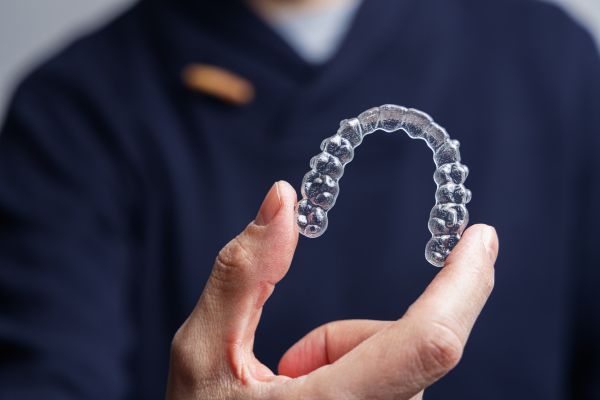Everyone who has ever wanted straighter, more beautiful teeth has asked themselves the question…. Are metal braces my only option for teeth straightening? (Nope! We’ll get into that shortly.) Modern orthodontics has created some amazing options for those seeking discreet or obvious ways to straighten teeth. But which to choose? The traditional braces are the ultimate teeth straightening method, or are clear braces the better option? That’s the big question in the clear aligners vs braces debate.
Spoiler: there’s no one-size-fits-all answer. But the good news? You’ve got options, and this guide is here to help you sort through them like a friend who’s already been there.
What Are Clear Aligners? And Why Are They Everywhere Now?
You’ve probably seen the ads or know someone who’s using them. Clear aligners for teeth are nearly invisible, removable trays that gently shift your teeth over time. You wear them most of the day (about 20–22 hours), pop them out to eat or brush, and switch to a new set every couple of weeks as your teeth move into place.
The cool part? Some companies offer at-home teeth straightening, where the whole thing, from impressions to aligners, happens without ever sitting in a dentist’s chair.
It’s like the 2020s version of braces: sleek, low-key, and designed to fit into your life, not the other way around.
The Case for Traditional Braces
Now, let’s not knock the OGs. Traditional braces, with their brackets, wires, and all, have been around for decades, and for good reason. They’re super effective, especially for more complex dental problems like rotated teeth, bite issues, or severe crowding.
They’re not removable (which some people actually like), and your orthodontist is hands-on the whole way, making sure everything’s shifting as it should.
But let’s be honest: they’re also a bit of a commitment. There are food restrictions, more frequent office visits, and yes, they’re visible.
Clear Aligners vs Braces: Which One’s Better for You?
Honestly? It depends on you, your smile, your goals, your schedule, and even your personality.
Let’s compare the two in plain language:
| Feature | Clear Aligners (Clear Braces) | Traditional Braces |
| Look | Barely noticeable | Metal (or ceramic, which is less visible) |
| Removable? | Yes—take them out to eat, brush, etc. | No—you’re committed full-time |
| Comfort | Smooth plastic, less irritation | Wires can poke and cause soreness |
| Ease of Cleaning | Easy to brush and floss normally | Tricky—requires special tools |
| Treatment Time | 4–12 months for mild/moderate cases | 12–24 months depending on complexity |
| Best For | Mild to moderate misalignment | Complex dental issues |
| Maintenance | Discipline needed (you have to wear them) | No choice—you can’t take them off |
| Cost | Often more affordable, especially at-home kits | Can be pricier, especially with in-office care |
When Clear Aligners Make Sense
Picture this: You’re in meetings all day. You’re dating. You’ve got a big event coming up. You want to straighten your teeth, but without the whole world knowing.
Clear aligners are perfect if you:
- Want something discreet
- Can commit to wearing them consistently
- Have mild to moderate alignment concerns
- Prefer fewer office visits (or none at all with at-home kits)
And here’s the kicker: If you’re looking for at-home teeth straightening, clear aligners are your only option. Some brands will send everything you need to your door, and you can do it all without taking time off work or rearranging your week around dental appointments.
When Braces Are the Better Bet
Now, if your dentist says your teeth are doing some next-level crowding or your bite is seriously out of sync, braces may be your best move.
They’re especially helpful if:
- You’ve got a complex case that needs precise corrections
- You don’t want the pressure of remembering to wear aligners
- You prefer to be under the regular care of an orthodontist
Yes, they’re visible. Yes, you’ll need to skip the popcorn and gummy candy for a while. But they’re reliable—and they work, even when aligners might not be enough.
But What About Cost?
Let’s talk money for a second.
Clear aligners, especially at-home options, can often cost less than traditional braces. Why? Fewer appointments, no overhead from a dental office, and you’re doing most of it on your own (with virtual support).
That said, insurance coverage varies. It’s always worth checking whether your provider covers braces, aligners, or both, and whether there’s a difference if you go in-clinic vs. at-home.
Final Thoughts: What’s Right for You?
The final decision is yours to make. Choose the option that goes best with your lifestyle and needs.
If you prefer something that will be easy to maintain and is invisible so no one will know, choose clear aligners. There are many affordable options to choose from and many at home clear aligner providers who give even installment options.
But if you have severe teeth misalignment braces may be a better option for you as it will give your orthodontist more control over your teeth’s movement.
At the end your best option is what is best suited to your needs.
